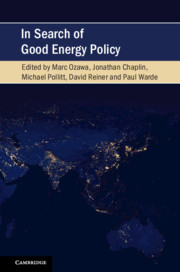Book contents
- In Search of Good Energy Policy
- In Search of Good Energy Policy
- Copyright page
- Contents
- Figures
- Tables
- Contributors
- Acknowledgments
- 1 Introduction
- Part I Multidisciplinary Perspectives
- Part II Cases and Multidisciplinary Responses
- 10 The Ethics of Nuclear Energy: Its Past, Present and Future1
- 11 Fukushima and German Energy Policy 2005–2015/2016
- 12 Rethinking the Environmental State: An Economic History of the Swedish Environmental Kuznets Curve for Carbon
- 13 Fossil Fuel Systems to 100 Per Cent Renewable Energy-Based Smart Energy Systems: Lessons from the Case of Denmark, 1973–2017
- 14 The Politics of Carbon Capture and Storage: How Interests Have Outstripped Economics in Shaping the Evolution of a Technology
- 15 Scaling Clean Energy for Data Centres: Trends, Problems, Solutions
- 16 Public Participation in the Context of Energy Activities: The Role of the Aarhus Convention Compliance Committee
- 17 Biofuel Energy, Ancestral Time and the Destruction of Borneo: An Ethical Perspective
- 18 From Inspiration to Implementation: Laudato Si’, Public Theology and the Demands of Energy Policy
- Part III Multidisciplinary Cases
- Index
- References
17 - Biofuel Energy, Ancestral Time and the Destruction of Borneo: An Ethical Perspective
from Part II - Cases and Multidisciplinary Responses
Published online by Cambridge University Press: 10 June 2019
- In Search of Good Energy Policy
- In Search of Good Energy Policy
- Copyright page
- Contents
- Figures
- Tables
- Contributors
- Acknowledgments
- 1 Introduction
- Part I Multidisciplinary Perspectives
- Part II Cases and Multidisciplinary Responses
- 10 The Ethics of Nuclear Energy: Its Past, Present and Future1
- 11 Fukushima and German Energy Policy 2005–2015/2016
- 12 Rethinking the Environmental State: An Economic History of the Swedish Environmental Kuznets Curve for Carbon
- 13 Fossil Fuel Systems to 100 Per Cent Renewable Energy-Based Smart Energy Systems: Lessons from the Case of Denmark, 1973–2017
- 14 The Politics of Carbon Capture and Storage: How Interests Have Outstripped Economics in Shaping the Evolution of a Technology
- 15 Scaling Clean Energy for Data Centres: Trends, Problems, Solutions
- 16 Public Participation in the Context of Energy Activities: The Role of the Aarhus Convention Compliance Committee
- 17 Biofuel Energy, Ancestral Time and the Destruction of Borneo: An Ethical Perspective
- 18 From Inspiration to Implementation: Laudato Si’, Public Theology and the Demands of Energy Policy
- Part III Multidisciplinary Cases
- Index
- References
Summary
The European Commission’s 2009 Renewable Energy Directive (RED) mandates that 10 per cent of liquid fuels used in the European Union must be composed of plant-derived fuels by 2020. The forests of Borneo, like those of other tropical regions, have been and are being destroyed, their rich biodiversity and human cultures eroded, and the stored greenhouse gases in their biomass and soils released to the atmosphere, in order to generate short-term profits from primary resource markets for tropical timber and tropical plantation products including EC-mandated biofuels. However far from saving carbon and protecting biodiversity, the promotion of these fuels has the opposite effects. From an ethical perspective the regulation on biofuels reveals an ontological misunderstanding of persons and other beings, which puts short-term accumulation of economic value above longer-term values. The medium-term temporality of global climate governance, combined with the short-term utilitarian calculus, has through this regulation supplanted ancestral temporalities which have traditionally governed the viability of tropical ecosystems and the ways of life for humans and other animals to dwell energetically and sustainably.
- Type
- Chapter
- Information
- In Search of Good Energy Policy , pp. 237 - 256Publisher: Cambridge University PressPrint publication year: 2019
References
- 2
- Cited by

